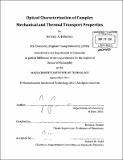Optical characterization of complex mechanical and thermal transport properties
Author(s)
Johnson, Jeremy A. (Jeremy Andrew)
DownloadFull printable version (24.36Mb)
Other Contributors
Massachusetts Institute of Technology. Dept. of Chemistry.
Advisor
Keith A. Nelson.
Terms of use
Metadata
Show full item recordAbstract
Time-resolved impulsive stimulated light scattering (ISS), also known as transient grating spectroscopy, was used to investigate phonon mediated thermal transport in semiconductors and mechanical degrees of freedom linked to structural relaxation in supercooled liquids. In ISS measurements, short optical pulses are crossed to produce a periodic excitation profile in or at the surface of the sample. Light from a probe beam that diffracts off the periodic material response is monitored to observe the dynamics of interest. A number of improvements were put into practice including the ability to separate so-called amplitude and phase grating signal contributions using heterodyne detection. This allowed the measurement of thermal transport in lead telluride and gallium arsenide-aluminum arsenide superlattices, and also provided the first direct observation of the initial crossover from diffusive to ballistic thermal transport in single crystal silicon and gallium arsenide at room temperature. Recent first-principles calculations of the thermal conductivity accumulation as a function of phonon mean free path allowed direct comparison to our measured results. In an effort to test theoretical predictions of the prevailing first principles theory of the glass transition, the mode coupling theory (MCT), photoacoustic measurements throughout much of the MHz acoustic frequency range were conducted in supercooled liquids. Longitudinal and shear acoustic waves were generated and monitored in supercooled liquid triphenyl phosphite in order to compare the dynamics. An additional interferometric technique analogous to ISS was developed to probe longitudinal acoustic waves at lower frequencies than was typically accessible with ISS. Lower frequency acoustic data were collected in supercooled tetramethyl tetraphenyl trisiloxane in conjunction with piezotransducer, ISS, and picosecond ultrasonics measurements to produce the first truly broadband mechanical spectra of a viscoelastic material covering frequencies continuously from mHz to hundreds of GHz. This allowed direct testing of the MCT predicted connection between fast and slow relaxation in supercooled liquids. Measurements of the quasi-longitudinal speed of sound in the energetic material cyclotrimethylene trinitramine (RDX) were also performed with ISS and picosecond ultrasonics from 0.5 to 15 GHz in order to resolve discrepancies in published low and high frequency elastic constants.
Description
Thesis (Ph. D.)--Massachusetts Institute of Technology, Dept. of Chemistry, 2011. Page 176 blank. Cataloged from PDF version of thesis. Includes bibliographical references (p. 163-175).
Date issued
2011Department
Massachusetts Institute of Technology. Department of ChemistryPublisher
Massachusetts Institute of Technology
Keywords
Chemistry.